
Best Packing Materials: Must-Have Moving Supplies
Planning a DIY move but unsure of the best packing materials? This ultimate guide to the top packing supplies has you covered!
BP Wholesale | August 15 2024Let's face it—packing for a house move isn't exactly anyone's idea of fun. No wonder, Brits cited moving house as the most stressful life event—51% and 62% for men and women, respectively.
Planning a DIY move but unsure of the best packing materials? This ultimate guide to the top packing supplies has you covered!
The last thing you want is shattered items or broken collectibles raising your stress levels. To avoid these headaches and keep your move budget-friendly, packing yourself is a smart choice. Struggling with how to pack your belongings efficiently and safely? We have the solutions you need!
For those looking to save on packing materials, you can buy these items and more at wholesale pricing directly from B&P Wholesale. Not only do we offer competitive prices, but we also deliver right to your doorstep, making your moving preparations smoother and more affordable. Shop Now!
Must-Have Moving Supplies for a Seamless Move!
Let's get a clear overview of the packing materials you'll likely need for your move:
- STORAGE - Moving boxes, specialty boxes, and garbage bags.
- LABELING - Label stickers for boxes, fragile stickers, and permanent markers.
- SECURING - Heavy-duty packing tape with a dispenser, tape gun, and rope.
- PACKING - Bubble wrap, foam wrap, packing paper, packing peanuts, and mattress covers.
- UNPACKING - Box cutter, scissors, and garbage bags.
- MOVING - Measuring tapes, disposable gloves, paper towels, cords, moving blankets, and door stoppers.
- HEAVY LIFTING - Mover's dolly, furniture lifter, shoulder dolly straps, furniture sliders, back brace, hand truck, and trailers.
Must-Have Packing Materials & How to Use Them Properly
1. Moving Boxes
Moving boxes are foundational to any move, whether it's relocating a home, office, or sending shipments. These versatile containers are indispensable due to their durability, affordability, and eco-friendly properties.
Types of Standard Moving Boxes and Their Uses
| Standard Box Type | Size | Best Use |
| Small Box | 6" x 12" x 12" | Ideal for compact, heavy items like tools, DVDs, CDs, and books. Packing heavier items in smaller boxes makes them easier to carry. |
| Medium Box | 18" x 16" x 18" | Great for a variety of household items including toys, electronics, clothes, and small appliances. Also suitable for kitchen dishes with proper padding. |
| Large Box | 18" x 18" x 24 | Best for bulkier soft goods like curtains, bedding sheets, and shoes. |
| Extra Large | 24" x 20" x 24" | Reserved for very large items such as collectible vases, oversized appliances, or bulky furniture pieces. |
Effective Packing Strategies for Moving Boxes
Using moving boxes efficiently ensures the safety and organization of your belongings:
Weight Distribution: Always place heavier items at the bottom of the box and lighter items on top to prevent damage.
Avoid Overloading: Refrain from packing a box with too many heavy items to make it manageable and to avoid breaking.
Fill Gaps: Use packing peanuts, bubble wrap, or crumpled packing paper to fill empty spaces within boxes to prevent items from shifting during transport.
Book Packing Technique: When packing books, place heavier books at the bottom and fill any remaining gaps with packing paper to keep them secure.
2. Specialty Moving Boxes
Aside from using standard moving boxes, you’d also need specialized cardboard boxes designed to hold specialty items.
Picture/Artwork Moving Boxes
These specialized carton boxes are tailored for packing and transporting framed artwork, large pictures, collectibles, and mirrors. While smaller frames can be accommodated in standard boxes with adequate padding, larger and more delicate items require these custom solutions to prevent scratches and breakage.
Foam pouches or foam wrap rolls are ideal for individually wrapping each item within these boxes, offering extra protection.
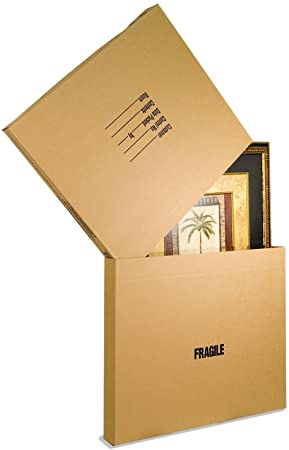
Wardrobe Boxes
Concerned about keeping your office attire and formal wear pristine during a move? While standard boxes can suffice for folded garments, wardrobe boxes offer a superior solution.
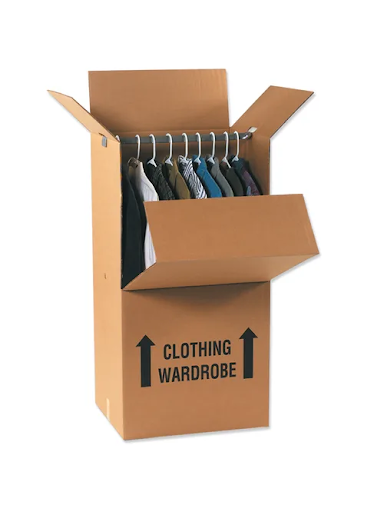
These boxes allow you to hang your clothes directly on a metal bar, just as in a closet, which not only protects them from wrinkles and dirt but also simplifies the unpacking process. Upon arrival at your new home, simply transfer the clothes directly into your closet.
However, it's worth noting that wardrobe boxes are larger and more costly, and they occupy significant space in a moving truck.
Dish Pack Cartons
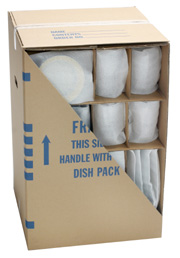
Also known as dish barrels, these boxes are indispensable for moving kitchens. They come equipped with custom partitions inside to snugly fit dishes, bowls, and cups, ensuring that each piece remains secure and separated throughout the move. This specialized design significantly reduces the risk of damage during transportation.
TV Boxes
These are designed to protect flat-screen TVs. The heavy-duty construction and foam inserts safeguard screens from impact and vibration.
Mattress Boxes
Available in various sizes to fit different mattress dimensions, these boxes protect your mattress from dirt, moisture, and damage during the move.
Mirror Boxes
Similar to picture boxes but tailored for mirrors, these can be adjusted to fit mirrors of any length and provide ample protection on all sides.
3. Plastic Boxes
.png)
Plastic boxes offer several advantages over traditional cardboard options, making them a smart choice for certain items during a move. One of the most notable benefits is their transparency, which allows you to see the contents inside without the need to open the box. This feature can greatly simplify both the packing and unpacking processes, especially when you need to quickly locate specific items.
When to Use Plastic Boxes
Moisture-Sensitive Items: If you're moving in rainy weather or storing items in a damp environment, plastic boxes are your best bet for keeping belongings dry and safe.
Fragile Items: Use plastic boxes for delicate items that need extra protection. You can also add padding, such as bubble wrap or foam, inside the box to further cushion fragile items.
Long-Term Storage: Plastic boxes are ideal for items that may remain packed for a while after the move. Their durability ensures that contents remain protected over time.
Tips for Packing with Plastic Boxes
Organize by Category: Use plastic boxes to group similar items together, such as seasonal clothing, holiday decorations, or important documents. Label the boxes clearly for easy access.
Mix and Match: Consider using a combination of transparent plastic boxes and opaque ones. Use transparent boxes for items you'll need to find quickly, and opaque ones for items that are less urgent.
Secure the Lids: Make sure the lids are tightly secured before stacking the boxes to prevent them from popping open during the move.
4. Label Stickers
Label stickers are indispensable tools for organizing a move efficiently. By employing color-coded sticker labels, you can streamline the packing and unpacking processes, ensuring that boxes are correctly identified and placed in their intended rooms without the need to peek inside each one.
Types of Label Stickers
Room-Specific Labels: These labels are color-coded for easy identification and can be assigned to various rooms such as the kitchen, living room, bathroom, and bedrooms. This system not only simplifies the placement of boxes in your new home but also aids movers in knowing where to deposit each box.
Fragile Stickers: Use bright, easily visible stickers to mark boxes containing breakable items. This alerts anyone handling the boxes to exercise extra care.
Best Practices for Using Label Stickers
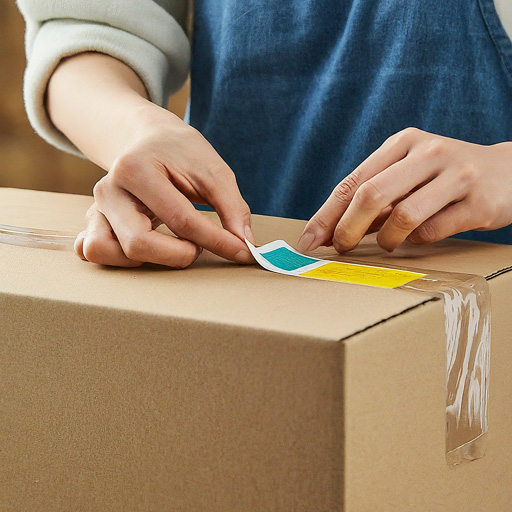
- Placement: Attach labels on multiple sides of each box to ensure they are visible regardless of how the boxes are stacked. Consider placing them on the top and at least one side.
- Visibility: Opt for high-contrast colors that stand out against the cardboard. This makes them easy to read from a distance.
- Detailing: In addition to basic labeling, you can write a brief description of the box's contents with a permanent marker directly on the label. This can be particularly useful for boxes that need to be unpacked first, like those containing essential kitchen supplies or bedding.
- Handling Instructions: Labels such as "This Side Up" or "Top Load Only" can be crucial for protecting the contents during the move. Use these for electronics, glass items, or other particularly sensitive belongings.
Enhanced Labeling Techniques
From the top search results, several advanced labeling strategies can be adopted for even better organization:
- Numbering System: Each box can be numbered, and a corresponding inventory list can be created to detail the contents of each numbered box. This is especially useful for long-distance moves where tracking items is critical.
- QR Codes: Some movers are now using QR codes on labels, which can be scanned to reveal detailed information about the box's contents without opening it. This tech-savvy approach can greatly speed up the unpacking process.
- Priority Tags: Tags or stickers indicating priority levels can help in unpacking the most essential boxes first, thereby reducing the initial chaos of moving in.
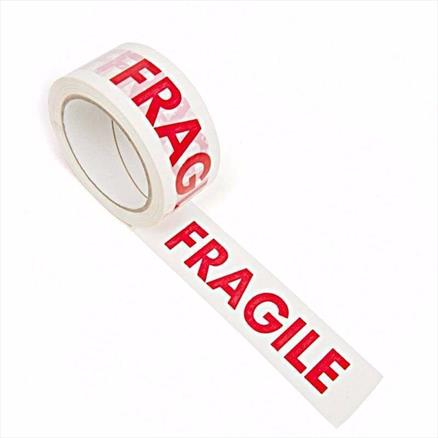
Don’t overlook the importance of clearly marking boxes containing delicate items. B&P’s `Fragile Tape is a must-have for identifying fragile goods. Its bold, clear print ensures that movers handle your delicate items with the extra care they require, reducing the risk of damage during the hectic moving process.
5. Bubble Wrap
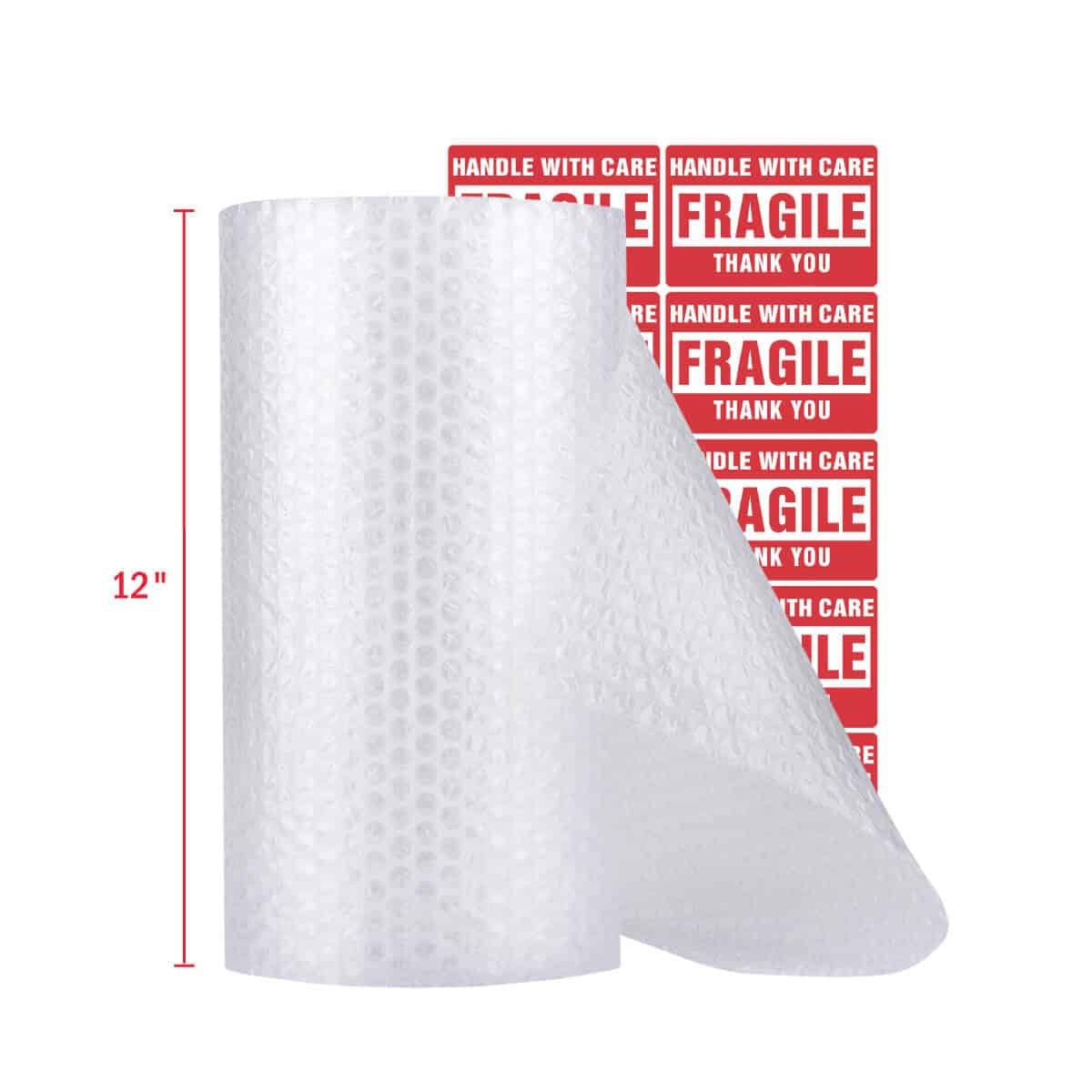
Bubble wrap is a highly versatile packing material that provides excellent protection for fragile and breakable items during a move. Originally popular in the shipping and packaging industries, bubble wrap has become a household favorite for safeguarding delicate possessions during relocations. Available in various sizes, qualities, and types, bubble wrap is a must-have for anyone looking to ensure their items remain intact throughout the moving process. Additionally, bubble wrap can be used to cover sharp furniture edges or table corners to prevent accidents during the move.
How to Properly Use Bubble Wrap
- Initial Layer of Protection: Begin by gently wrapping your item with packing paper. This first layer adds a soft cushion and prevents direct contact between the item and the bubble wrap, reducing the risk of scratches.
- Apply Bubble Wrap: After the packing paper, wrap the item securely with bubble wrap. Ensure the bubbles face inward toward the item for maximum cushioning effect.
- Secure with Packing Tape: Use high-quality packing tape to keep the bubble wrap in place. Make sure the tape is firmly applied to prevent the wrap from unraveling during the move.
- Extra Protection for Hollow Items: For glassware, mugs, or vases, add an extra layer of protection by placing a piece of bubble wrap or packing peanuts inside the opening. This helps cushion the interior and provides additional shock absorption.
- Cover Furniture Edges: Bubble wrap can also be used to cover the protruding edges of furniture, such as table corners or bedposts. This not only protects the furniture itself but also prevents injuries from accidental bumps during the move.
Additional Tips for Using Bubble Wrap
- Line Your Boxes: Consider lining the interior of your moving boxes with bubble wrap. This creates a buffer that absorbs impact and protects the contents from external shocks.
- Choose the Right Type: Opt for high-quality, durable bubble wrap, especially for heavier or more valuable items. This ensures the wrap doesn’t tear or puncture, compromising the protection.
- Eco-Friendly Alternatives: If you’re environmentally conscious, look for biodegradable bubble wrap options. These offer the same level of protection while reducing your environmental footprint.
6. Packing Paper
Packing paper is one of the most essential materials to have on hand during a house move. It serves as a versatile protective layer that shields your items from dust, breakage, scuffs, and scratches. Highly affordable and easily purchased in bulk, packing paper is a staple in any moving kit.
While packing paper is invaluable on its own, it is most effective when used in combination with other packing materials such as boxes, bubble wrap, foam wraps, or styrofoam. Its primary role is to add an extra layer of protection, keep items in place, and cushion them against minor vibrations during transport.
Packing paper is also excellent for filling empty spaces in boxes, preventing items from shifting and getting damaged. Given its versatility and importance, packing paper is a must-have for any move.
How to Properly Use Packing Paper
- Wrap Each Item Individually: Before placing multiple items in a box, wrap each one individually in packing paper. This prevents direct contact between items and provides a protective barrier against scratches and impact.
- Secure the Paper (Optional): If needed, you can secure the packing paper with a small piece of packing tape to ensure it stays in place during the move.
- Fill Voids in Boxes: Use crumpled packing paper to fill any empty spaces in your boxes. This not only keeps items from shifting but also adds a layer of cushioning that absorbs shocks during transport.
- Layering for Fragile Items: When packing particularly fragile items like glassware or ceramics, layer the box with packing paper at the bottom before placing the items inside. Add more paper between layers of items for added protection.
Packing Paper Guidelines: How Much Do You Need?
- Small Household or Studio Apartment: If you live alone in a one-bedroom house or studio apartment, you’ll need approximately 100 to 200 sheets of packing paper.
- Medium-Sized Home: For a house with multiple rooms, plan on using 400 to 500 sheets of packing paper.
- Large Home with Fragile Items: If you have a large home with a lot of delicate items, you may require around 1,000 sheets.
- Collector or Large Household: For those with 6 to 7+ bedrooms or a significant collection of fragile items, you should consider purchasing up to 2,000 sheets of packing paper.
For those seeking eco-friendly alternatives to standard packing paper, B&P Wholesale offers White Acid-Free Tissue Paper and MG Brown Kraft Sheets. These options are not only gentle on your items but also on the environment. Perfect for wrapping glassware or filling spaces in your moving boxes to prevent item movement and potential damage during transport.
7. Packaging Tape
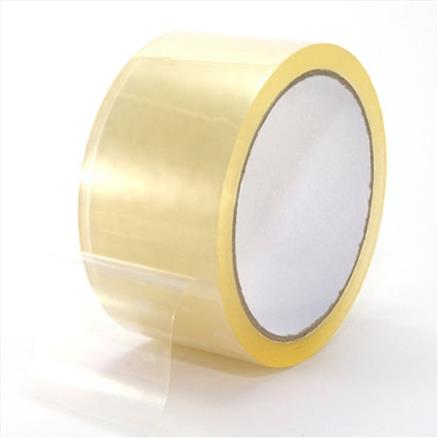
Not all packaging tapes are created equal. It might be tempting to reach for the cheapest option, but this is one area where cutting corners can lead to disaster. Cheap, low-quality tape can fail under the stress of a move, leading to boxes popping open, contents spilling out, and valuable items being damaged. To avoid turning your moving day into a nightmare, invest in heavy-duty packaging tape designed to withstand the rigors of moving.
Types of Packaging Tape
- Heavy-Duty Packaging Tape: This tape is thicker and stronger than standard tape, providing a secure seal that won't easily break under the weight of your boxes.
- Water-Activated Tape: Also known as gummed tape, this option creates an extremely strong bond when moistened. It's ideal for heavy or high-value items where maximum security is required.
- Fragile Tape: Some packaging tapes come pre-labeled with "Fragile" warnings, making it easy to identify and prioritize boxes that require extra care.
To ensure your boxes are securely sealed, consider using B&P Wholesale's robust packing tapes like the `2" Brown Buff Tape` or `2" Clear Sellotape packing tape`. These tapes offer strong adhesion that’s perfect for heavy boxes and long moves, ensuring that your belongings stay secure from your old home to your new one. Each roll provides excellent value, minimizing the risk of tape failure during critical moving times.
How to Use Packaging Tape Effectively
- Seal All Seams: When taping your boxes, make sure to seal all seams securely. This includes the top, bottom, and any flaps. Apply tape across the center seam, and then reinforce with strips along the edges.
- Use the H-Taping Method: For added security, use the H-taping method. After sealing the center seam, apply tape along the edges of the box, creating an "H" shape on both the top and bottom. This method provides additional reinforcement, especially for heavier boxes.
- Double Tape for Heavy Items: For boxes containing heavy items, consider applying a double layer of tape to ensure the bottom of the box doesn’t give way during the move.
- Label with Tape: If you don’t have fragile stickers, you can use a piece of packaging tape to label boxes. Simply write the label with a permanent marker on the tape before applying it to the box.
8. Packing Foam
Packing foam, especially foam wrap sheets, is an excellent material for providing extra safety to fragile items during a move, whether you’re relocating your home or shipping valuables. These sheets offer a layer of cushioning that can protect delicate items such as plates, glassware, and other breakable objects from damage. Additionally, packing foam is versatile enough to be used on furniture edges to prevent scratches and dings. When selecting foam sheets, opt for those that are non-abrasive, sturdy, and soft to ensure they protect your items without causing any damage themselves.
How to Properly Use Packing Foam
- Wrap Fragile Items: Use foam sheets to wrap individual items such as dishes, bowls, and glassware before placing them in a box. This not only cushions them but also prevents them from rubbing against each other during the move.
- Protect Furniture Edges: Apply foam sheets to the corners and edges of furniture pieces. This helps to avoid scratches and dents, especially when moving through tight spaces or during loading and unloading.
- For Collectibles and Delicate Items: If you’re a collector or have items that are particularly delicate, packing foam provides the necessary protection to keep these valuables safe, even if they are in storage for an extended period.
- Layering for Maximum Protection: For added security, consider layering foam sheets between stacked items in a box. This is particularly useful for plates and other flat items that might be stacked together.
9. Packing Peanuts
Packing peanuts may not be the most popular packing material, but they do offer certain advantages when used correctly during a house move. These lightweight, foam pieces come in various shapes and sizes and are primarily used to fill empty spaces in boxes, preventing items from shifting during transit. While packing peanuts are not as durable or reusable as other packing materials, they can still be valuable in certain situations, especially for providing cushioning in boxes with fragile items.
How to Properly Use Packing Peanuts
Line the Bottom of Boxes: Before placing items wrapped in packing paper or foam sheets inside a box, fill the bottom of the box with a layer of packing peanuts. This adds a cushion that absorbs shocks from below.
- Fill Voids and Gaps: Once your items are placed in the box, fill any remaining voids with packing peanuts. This helps to secure the items in place, preventing them from moving around and potentially getting damaged.
- Top Layer Protection: Before sealing the box, add a final layer of packing peanuts on top of the items. This ensures that they are fully surrounded and cushioned from all sides.
- Consider Eco-Friendly Options: While traditional packing peanuts are not reusable and can be environmentally harmful, there are now biodegradable options available. These eco-friendly peanuts dissolve in water and are a better choice for those looking to minimize their environmental impact.
Best Packing Materials for Unbreakable, Miscellaneous Things
These items include apparel, books, office supplies, and other durable goods that are less likely to suffer damage during a move. For these belongings, minimal cushioning is typically needed. The following packing materials are ideal for protecting and organizing these unbreakable items:
- Air pillows or poly bags
- Newsprint paper
- A small amount of bubble wrap
- Foam pouches
Packing Tips for Unbreakable Items
Organize by Weight: Pack heavier items like books in smaller boxes to avoid making them too heavy to lift. Lighter items like clothing can go in larger boxes or bags.
Label Clearly: Even though these items are less likely to break, clear labeling helps you or your movers handle them appropriately and find them quickly after the move.
Minimize Shifting: Fill any gaps in your boxes with air pillows, newsprint, or even rolled-up socks to keep items from moving around.
Best Packing Material for Fragile Items? Bubble Wrap, Packing Paper, Strong Cardboard Boxes

When it comes to packing and moving delicate items like dishes, glassware, and other fragile objects, the best approach is to use a combination of protective materials such as packing paper, bubble wrap, and foam sheets. These materials work together to provide the cushioning and security needed to prevent breakage during transit.
How to Pack Heavy Fragile Items
- Dishes and Glass Bowls: Start by separating individual dishes with foam sheets or packing paper. Then, wrap them in batches using large, durable bubble wrap to provide extra cushioning. This layering technique adds protection and reduces the risk of damage from impacts.
- Figurines and Display Items: For smaller, delicate items like figurines, wrap each piece individually in bubble wrap. Pack them in layers inside a sturdy box, separating each layer with additional bubble wrap, foam sheets, or packing peanuts to prevent them from shifting.
- Box Selection: Use smaller moving boxes for heavy, fragile items to ensure they are easier to handle and less likely to be overfilled. Specialty boxes, designed specifically for fragile items, can also be used for added protection.
- Box Reinforcement: Before placing any items inside, reinforce the bottom of the box with extra strips of heavy-duty packing tape. This step ensures the box can support the weight of its contents without giving way.
- Cushion the Bottom: Line the bottom of the box with a soft packing material like packing peanuts, foam, or bubble wrap. This provides a shock-absorbing base for your fragile items.
- Placement and Padding: Place the heaviest items at the bottom of the box and fill any voids with packing paper or peanuts to prevent movement. This helps distribute the weight evenly and reduces the risk of items shifting during transport.
- Labeling: Always label your boxes containing fragile items with "Fragile" stickers to alert movers to handle them with care.
Best Packing Material for Furniture? Moving Blankets/Pads, Stretch Wraps
Moving Blankets or Furniture Pads
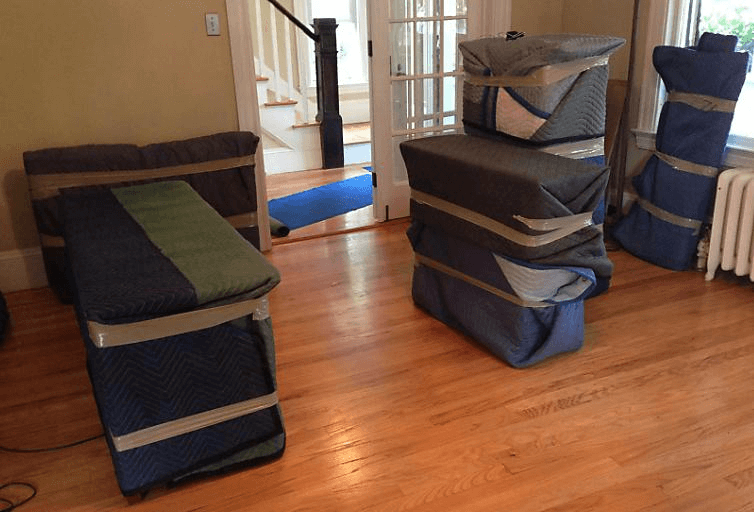
Moving Blankets or Furniture Pads
Moving blankets, also known as furniture pads, are thick, cushioned covers designed to protect the surfaces of your furniture during a move. These blankets are made from soft, durable materials that provide a protective layer against scratches, dents, and other potential damage caused by bumps and jolts during transport. To ensure the blankets stay in place, they can be secured with heavy-duty tape.
Pro Tip: Instead of tape, you can use ropes or cargo straps to secure moving blankets. This method not only keeps the blankets in place but also allows you to fasten the furniture to a dolly or inside the moving truck for added stability.
Stretch wrap
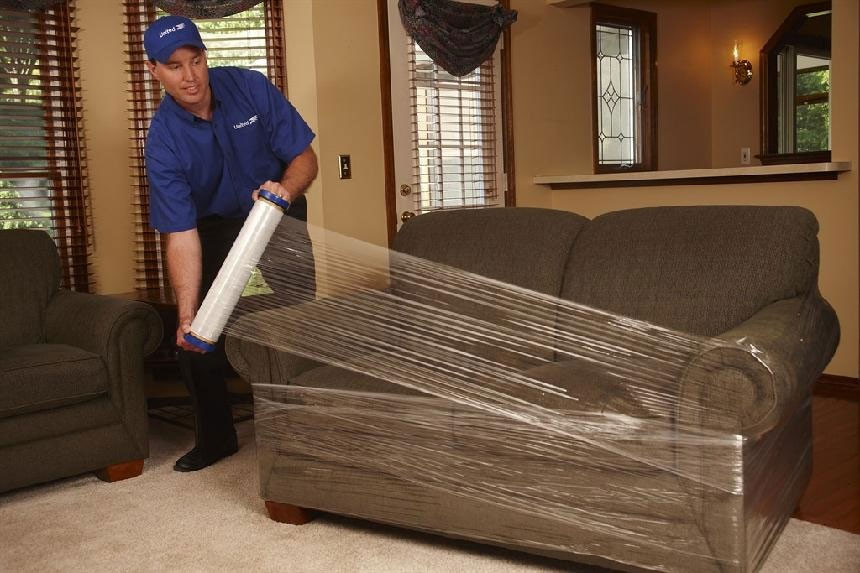
Stretch wrap is another essential material for protecting furniture during a move. This plastic film is wrapped tightly around items like dressers, drawers, and other bulky furniture to hold them together and prevent doors and drawers from opening during transport. Stretch wrap can also be used to bundle smaller items together, such as kitchen utensils, ensuring they stay organized and are less likely to get lost.
Best Way to Pack Your Furniture for a Move:
For the best protection during a move, start by wrapping your furniture, particularly soft-sided pieces, with moving blankets. Secure the blankets with heavy-duty tape or straps. For additional protection, especially against dirt and moisture, wrap the entire piece in stretch wrap. This double-layer approach ensures that your furniture is both cushioned and protected, reducing the risk of damage and keeping everything intact during the move.
How Much Packing Materials Would I Need?
Determining how much packing material you'll need for a move depends on various factors. Now that you're familiar with the essential packing materials, you might be asking: How much packing paper should I buy? How many boxes will I need for my home?
To answer these questions, you'll need to assess the volume of your belongings. The amount of packing materials required will vary based on several factors:
- Duration in Your Current Home: If you've lived in your home for a decade or more, you've likely accumulated more items, which means you'll need more packing materials. Tip: Declutter by discarding or donating items you no longer need before estimating the packing materials required.
- Household Size: Consider how many people live in your home and how many rooms you have. A larger household typically means more belongings to pack.
- Lifestyle and Habits: Are you a minimalist or a collector? Minimalists, who generally own fewer items, will require less packing material compared to collectors who may have a significant amount of items to pack.
To help you estimate, here are some general guidelines on the number of packing materials needed based on your lifestyle and home size:
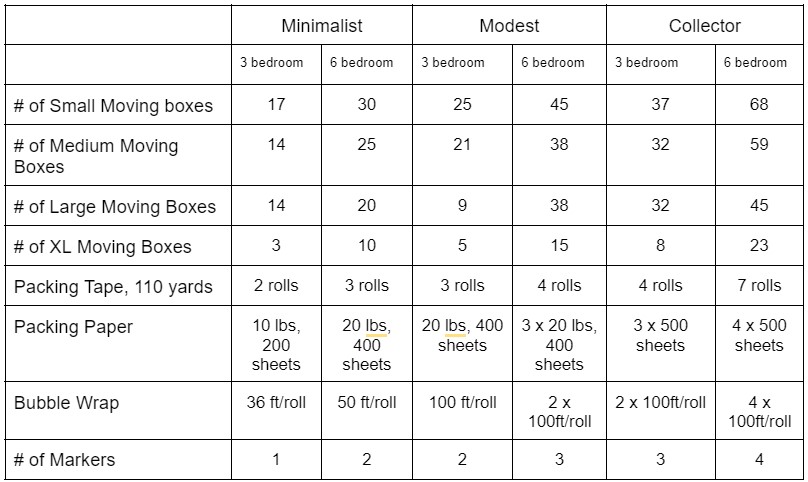
Having a calculator and a well-planned checklist can help you with your packing material checklist. With the same reasoning, you need to make sure you have the right amount of materials to pack your things adequately. You don’t want to end up losing or breaking items during the move because you lack cushioning or tapes.
It doesn’t matter if you have a long-distance move or local moving as most of the considerations rely on the bulk of things you have.
Packing Accessories You May Additionally Need
When preparing for a move, certain accessories can make the process smoother and more efficient. Here are some additional items you may want to have on hand:
1. Gloves
If you're handling a DIY move, gloves are essential for protecting your hands from cuts, punctures, and abrasions. Make sure to provide gloves for everyone helping with the move to ensure safety while packing and handling heavy or sharp objects.
2. Hand Trucks and Dollies
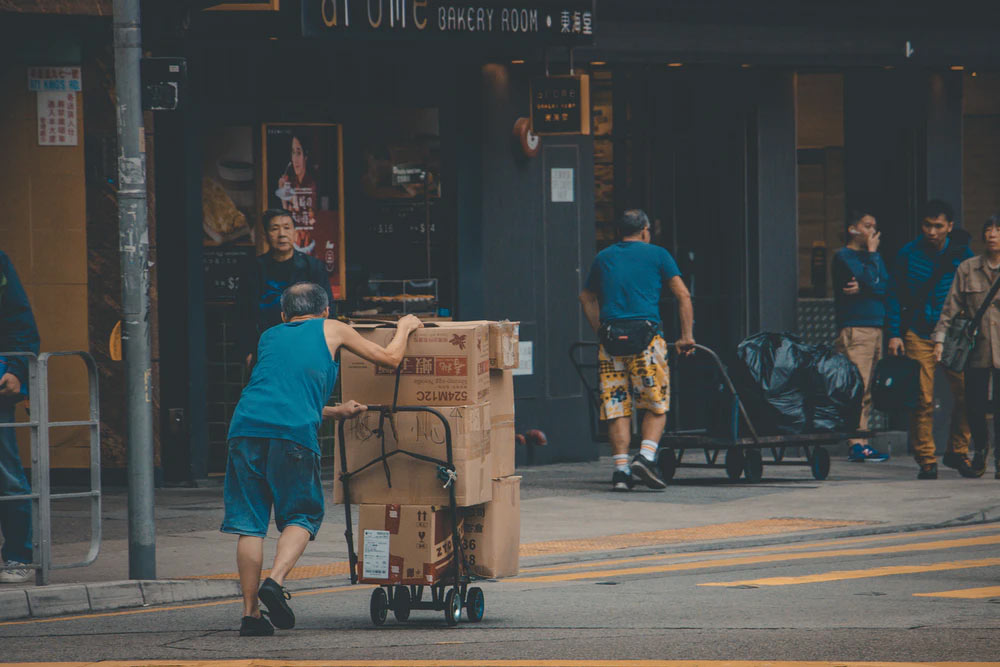
For moving heavy furniture and large boxes, renting hand trucks and dollies is highly recommended. These tools make it much easier to lift and transport bulky items, reducing the risk of injury and speeding up the moving process.
3. Box cutter
You’ll need one or two box cutters to assist with the unpacking process. These handy tools will help you quickly and safely open boxes, making the task of setting up your new home more efficient.
4. Cleaning Supplies and Trash Bags
Unpacking can generate a lot of debris, including packing materials, boxes, and other waste. Having cleaning supplies and trash bags on hand will help you keep your new space tidy as you settle in.
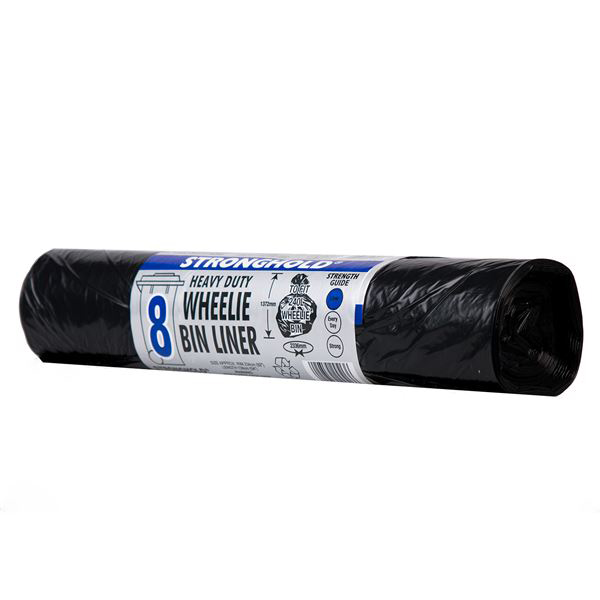
B&P’s `Stronghold Black Wheelie Bin Bags` and `Stronghold Medium Duty Refuse Sacks` are perfect for the cleanup phase of your move. These durable bags will handle all the post-move clutter, allowing for an efficient and tidy transition into your new home.
Wrapping Up
Your moving day is marked on the calendar, and while it’s exciting to start this new chapter, the packing process can feel overwhelming, especially when trying to stay within budget. We hope this guide has helped you discover the best packing materials for your move and provided useful tips on how to use them effectively. By optimizing your packing strategy, you can make the transition to your new home smoother and more cost-efficient.